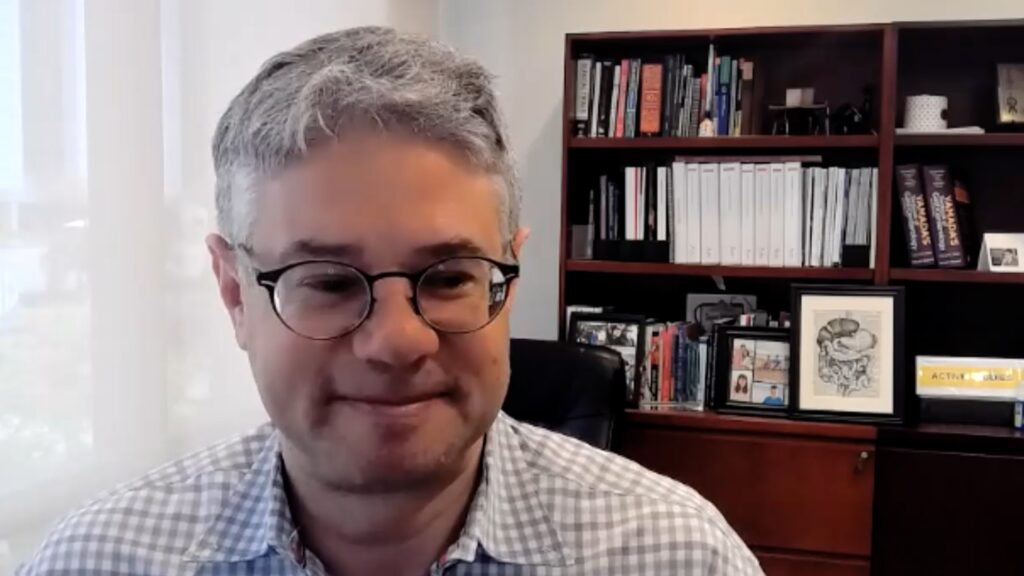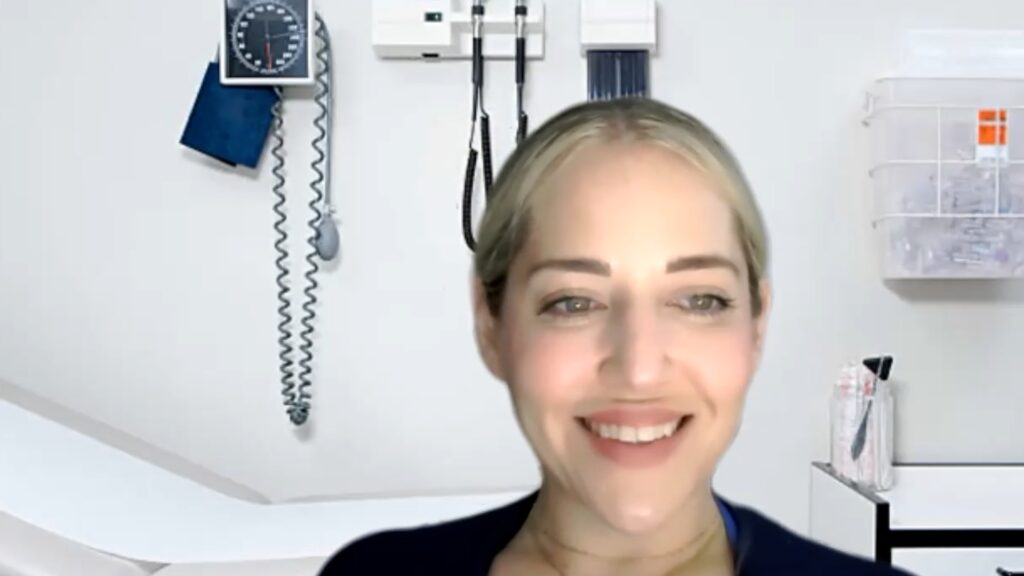 The STENOVA trial was a randomized, double-blind, placebo-controlled study investigating the safety, pharmokinetics and pharmacodynamics of AGMB-129 in participants with Crohn’s disease and symptomatic strictures. The study took place over 19 weeks and investigated 2 dose levels of AGMB-129. In this interview, Dr Florian Rieder (Gastroenterology, Hepatology & Nutrition, Cleveland Clinic, Cleveland, OH, USA) discusses the mechanism of action and the rationale for investigating AGMB-129 in this indication, the STENOVA trial design and the interim findings from the study.
The STENOVA trial was a randomized, double-blind, placebo-controlled study investigating the safety, pharmokinetics and pharmacodynamics of AGMB-129 in participants with Crohn’s disease and symptomatic strictures. The study took place over 19 weeks and investigated 2 dose levels of AGMB-129. In this interview, Dr Florian Rieder (Gastroenterology, Hepatology & Nutrition, Cleveland Clinic, Cleveland, OH, USA) discusses the mechanism of action and the rationale for investigating AGMB-129 in this indication, the STENOVA trial design and the interim findings from the study.
The abstract “A Phase 2a, Randomized, Placebo-controlled, Double-blind Study to Assess the Safety, Pharmacokinetics (PK) and Pharmacodynamics (PD) of AGMB-129 in Patients with Fibrostenotic Crohn’s Disease: Interim Results from the STENOVA Trial.” was presented at Digestive Disease Week 2025, San Diego, CA, USA; May 3–6, 2025.
Questions
- What are the unmet needs in the treatment of fibrostenosing Crohn’s disease (CD)? (0:18)
- What is the mechanism of action of AGMB-129? (1:03)
- What was the rationale for investigating AGMB-129 in fibrostenosing CD? (2:17)
- Could you give an overview of the STENOVA trial design and the clinical endpoints? (2:51)
- What were the interim findings from the study? (3:50)
Further content in inflammatory bowel disease.
Editor: Victoria Jones, Senior Content Editor.
Disclosures: This short article was prepared by touchIMMUNOLOGY in collaboration with Dr Florian Rieder. touchIMMUNOLOGY utilize AI as an editorial tool (ChatGPT (GPT-4o) [Large language model]. https://chat.openai.com/chat.) The content was developed and edited by human editors. No fees or funding were associated with its publication.
Florian Rieder has served on advisory boards or consulted for: Adiso, Adnovate, Agomab, Allergan, AbbVie, Arena, Astra Zeneca, Bausch & Lomb, Boehringer-Ingelheim, Celgene/BMS, Celltrion, CDISC, Celsius, Cowen, 89Bio, Eugit, Ferring, Galapagos, Galmed, Genentech, Gilead, Gossamer, Granite, Guidepoint, Helmsley, Horizon Therapeutics, Image Analysis Limited, Index Pharma, Landos, Jannsen, Koutif, Mestag, Metacrine, Mirum, Mobius, Mopac, Morphic, Myka Labs, Organovo, Origo, Palisade, Pfizer, Pliant, Prometheus Biosciences, Receptos, RedX, Roche, Samsung, Sanofi, Surmodics, Surrozen, Takeda, Techlab, Teva, Theravance, Thetis, Tr1x Bio, UCB, and Ysios.
Transcript
My name is Florian Rieder. I’m the Advice Department Chair and Co-section Head for inflammatory bowel diseases, and Director of the Program for Global Translational IBD at the Cleveland Clinic in Cleveland, Ohio.
Q. What are the unmet needs in the treatment of fibrostenosing Crohn’s disease (CD)? (0:18)
Crohn’s disease is a progressive disorder, and it has a relapsing remitting inflammatory disease course, but underneath the threshold of these inflammatory obstructive symptoms, you have accumulating tissue damage, such as for instance, accumulation of extracellular matrix or scar tissue, thickening of the muscularis propria that ultimately leads to stricturing symptoms in more than half of patients with Crohn’s disease in their lifetime. At the moment, there are only mechanical options to deal with this; endoscopic balloon dilation, surgical resection, and this represents a large unmet need.
Q. What is the mechanism of action of AGMB-129? (1:03)
The TGF-β pathway is the main driver of fibrosis, transforming growth factor-beta 1 is the major pro-fibrotic growth factor, its levels are increased in fibrotic tissues. In mouse models, if you upregulate it, they get more fibrosis and if you downregulate it, they get less and the TGF-β inhibition is clinically validated already in other diseases. One big problem is that TGF-β cannot be systemically inhibited because of the toxicity in hard, large vessels concerned for cancer and immune activation. TGF-β signalling is mediated through a receptor kinase called ALK5 and if you inhibit ALK5, you specifically and selectively inhibit TGF-β signalling. This molecule, AGMB-129, is a GI restricted ALK5 inhibitor that’s designed to avoid systemic toxicity to rapid hepatic metabolization, restricting AGMB-129 exposure to the GI tract, and hence, inhibiting TGF-β signalling selectively in the GI tract.
Q. What was the rationale for investigating AGMB-129 in fibrostenosing CD? (2:17)
The rationale is that the TGF-β 1 is the major growth factor across fibrotic diseases, including the intestine. You have the problem of stricture in Crohn’s disease being associated with fibrosis of the intestinal wall and blocking this ECM, acute extracellular matrix accumulation, through blocking TGF-β signalling, but avoiding systemic side effects was the rationale of the drug development program.
Q. Could you give an overview of the STENOVA trial design and the clinical endpoints? (2:51)
The STENOVA trial was a phase IIa trial, with patients with symptomatic ileal strictures, it was planned to be for ninety patients, randomized into three arms, placebo with an AGMB-129, 100 mg/once-a-day or 200 mg/twice-a-day. This was administered on top of standard-of-care and the standard-of-care was continued throughout the trial. The trial duration was 12 weeks, and patients received endoscopy and MR enterography at week 0 and at week 12 and then symptoms were recorded throughout this 12 week trial. At the end of 12 weeks, patients have the option to enter an open-label extension. Fifty two sites in the US, Canada, and the European Union have participated, and we just presented an interim analysis of the first 44 patients that completed week 12.
Q. What were the interim findings from the study? (3:50)
We had some very relevant findings. The primary endpoint was safety and tolerability, and AGMB-129 is safe and well tolerated in patients with fibrous stenosis and Crohn’s disease. The secondary endpoints are pharmacokinetics and pharmacodynamics and in line with the phase I data as well as animal data, AGMB-129 exhibited low systemic exposure, and then RNA sequencing of ileal biopsies is suggestive of target engagement of the TGF-β pathway, which is the mechanism of action of the drug. Then the very encouraging and multiple exploratory endpoints, a trend in reduction of stricture symptoms was noted, and this is the first time a dedicated stricture patient reported outcome tool was used. Surprisingly, the drug also worked in an anti-inflammatory manner, so the inflammatory scores on the endoscopic SCSCD score decreased. The strictures had increased passibility with the endoscope, suggesting a widening of the lumen and pre-stricture dilation on imaging, which may be considered a surrogate of passibility of the strictures; it was 6 mm less in the higher dose arm compared to placebo when you compare the baseline pre-stricture dilation with the twelve week pre-stricture dilation. Overall, these are only 44 patients, and this is an interim analysis, but this is very encouraging data for the field in a first-in-class, first-in-indication type trial.
Subtitles and transcript are autogenerated.
SIGN UP to TouchIMMUNOLOGY!
Join our global community today for access to thousands of peer-reviewed articles, expert insights, and learn-on-the-go education across 150+ specialties, plus concise email updates and newsletters so you never miss out.








